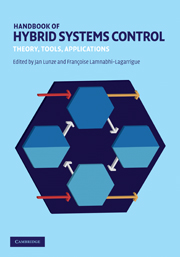16 - Networked control
from Part III - Applications
Published online by Cambridge University Press: 21 February 2011
Summary
Control loops which are closed over a digital communication network became a topic of intensive research in the recent years. This chapter surveys the main problems to be solved and show how hybrid systems theory can help to solve them. The chapter ends with a case study that was inspired by a practical application of hybrid systems methods in an ore mine.
Introduction to distributed control applications and networked control systems
In this chapter, we deal with control over networks, i.e. with control implementations where the control actions and decisions are taken based on measurement, decisions, and actuations that take place in a distributed environment. The control agents may rely upon a centralized facility that coordinates and optimizes the overall control strategy and on a shared communication resource like a bus (distributed control) or may be acting only on local information and on data exchanged with neighboring nodes (decentralized control). There are obviously pros and cons for each strategy. Decentralized control systems have the following characteristics:
There is no central control node.
There is no common communication facility; communication is point-to-point.
The global network topology is unknown to the nodes, which are only aware of their neighborhood.
These features yield interesting properties:
The system is scalable: there are no limits imposed by centralized computing power or global communication bandwidth.
The system is robust and fault tolerant, because it supports dynamical changes of the network topology and losses of nodes. […]
- Type
- Chapter
- Information
- Handbook of Hybrid Systems ControlTheory, Tools, Applications, pp. 471 - 500Publisher: Cambridge University PressPrint publication year: 2009
- 1
- Cited by

